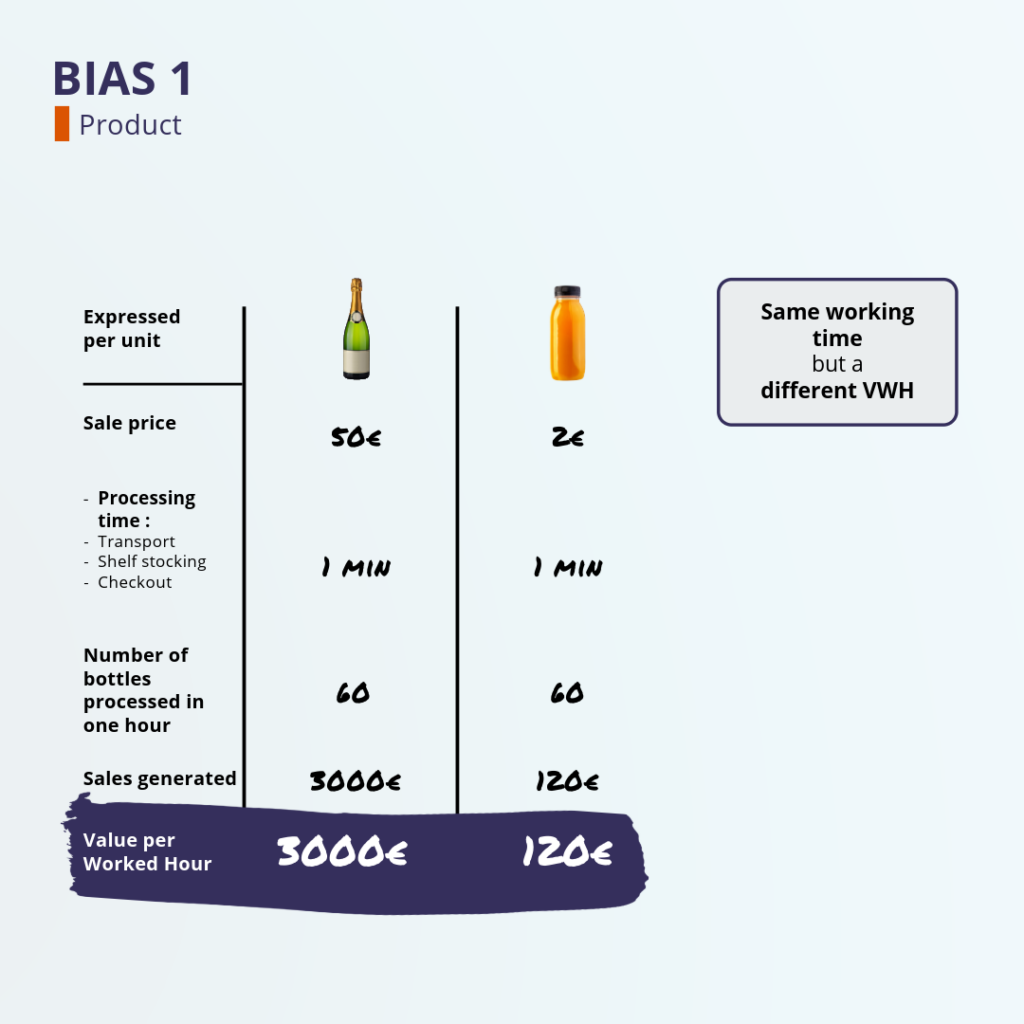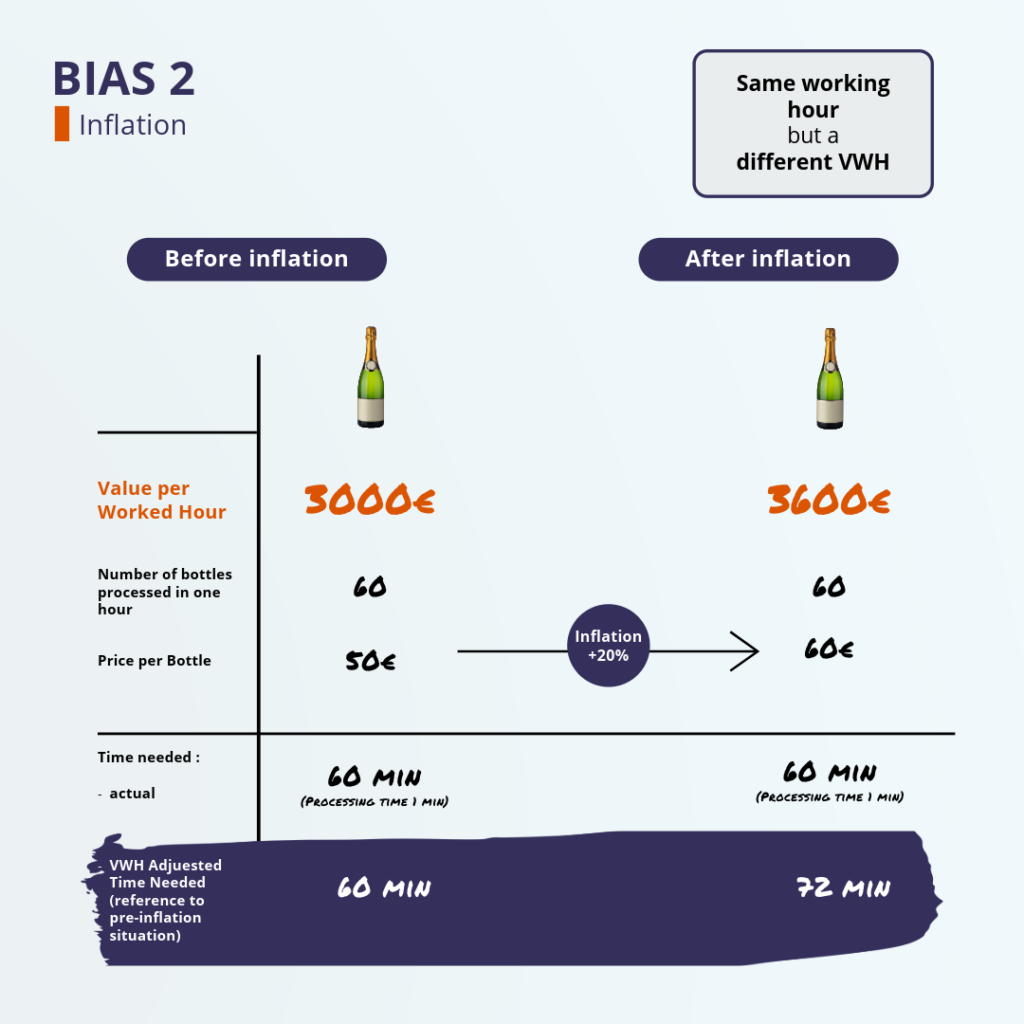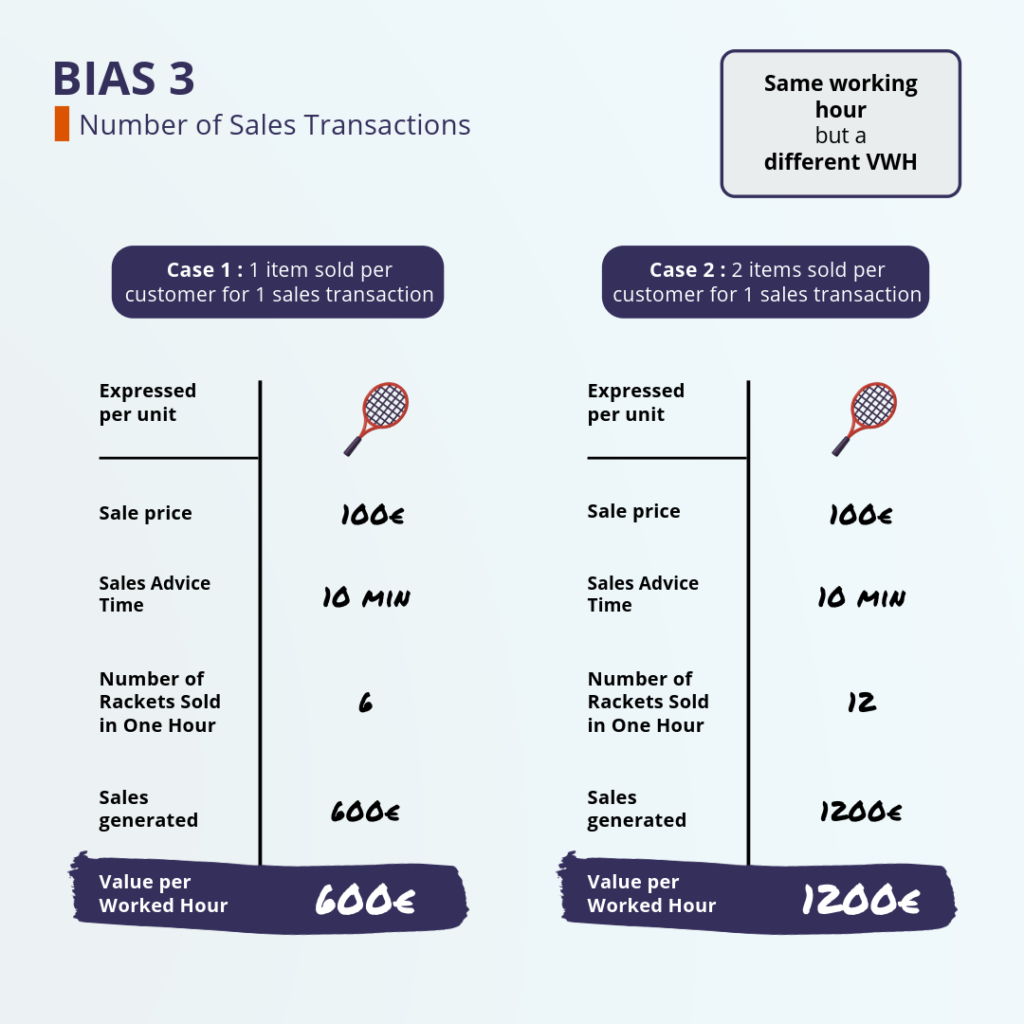Introduction
In the retail sector, the Value per Worked Hour (VWH) calculated from the revenue is often used as a key performance indicator to plan labor needs. However, this well-known metric can, if misused, introduce biases that distort the evaluation of resources and performance. Understanding these biases is essential for optimizing resource management and ensuring that your planning truly aligns with actual field needs.
I) Bias related to product type
The first common bias concerns the VWH by product type. The VWH can vary significantly from one product to another, even though the work time generated on each of the two products is the same.
Let’s take a concrete example:
- Shelf restocking time: 1 minute per bottle, whether it’s wine or orange juice.
- Selling price of a bottle of wine: 50€
- Selling price of a bottle of orange juice: 2€
In one hour, if 60 bottles of each product are stocked on the shelves, the calculated VWH will be 3,000 € for wine, compared to only 120 € for orange juice. If we only use the VWH to estimate the need for working hours, we could mistakenly believe that less time is needed to handle the bottles of orange juice, even though the workload is exactly the same for both product types.
We can also illustrate this bias with an example at the cash register:
Imagine a cashier scanning a case of champagne worth 200 € in one minute, thus generating a VWH of 12,000 € per hour. Conversely, during the back-to-school period, the same cashier takes 10 minutes to scan a basket containing several lower-value items, totaling 120 €. The VWH then drops to only 720 € per hour.
If we rely solely on the VWH to plan the necessary cashier hours, we could wrongly conclude that fewer cashiers are needed during the back-to-school period. In reality, handling these baskets, which contain more items, requires more time. This approach, therefore, does not account for the complexity and actual volume of work required for each type of transaction.
Conclusion: Relying solely on the VWH, without considering the nature of the products and the necessary processing time, risks misleading us about the actual resource needs. It is therefore essential to adopt a more comprehensive approach to accurately assess the required volume of working hours.

Avoid the biases induced by Value per Worked Hour
through workload calculation!
II) Bias related to inflation
Inflation is another factor that can skew the interpretation of the VWH.
Imagine that the selling price of a product increases by 20% due to inflation: the revenue generated per worked hour will automatically increase, even though the workload remains unchanged. This can create an illusion of improved performance, while in reality, only the monetary value has changed.
Let’s take a concrete example:
- Before inflation: A bottle of wine was sold for 50 €.
- After inflation: The same bottle is now worth 60 €.
Using the Value per Worked Hour (VWH) to estimate the need for working hours, one might wrongly conclude that more hours are needed to handle the same volume of 60 bottles per hour:
- Before inflation: 60 bottles represent a VWH of 3,000 €. The processing time remains constant at 1 minute per bottle, for a total of 60 minutes.
- After inflation: For the same 60 bottles, the VWH rises to 3,600 €. If we use the VWH before inflation to calculate the necessary time, one might mistakenly estimate that processing now requires 72 minutes, or 1.2 minutes per bottle instead of the initial 60 minutes.
However, the actual volume of hours required to complete this task remains unchanged. It may even decrease if the volume of products handled during inflation periods decreases. In times of inflation, it is therefore crucial not to rely solely on the VWH to plan resources, as this could lead to poor staff allocation.
For optimal planning, it is essential to base decisions on the actual workload, rather than a simple monetary assessment, to avoid deviations and better manage resources in an unstable economic context.

III) Bias related to the number of sales transaction
The last bias we will discuss concerns the number of sales transactions made.
To easily understand this, let’s take an example:
- Case 1: A seller sells one tennis racket per customer, for a price of 100 € each. In one hour, with a consulting time of 10 minutes per sale, he sells 6 rackets, thus generating 600 € in revenue per hour.
- Case 2: The same seller manages to advise two rackets per customer for the same consulting time. In one hour, he thus sells 12 rackets, generating 1,200 € in revenue per hour.
We can see that for a doubled VWH, the consulting time remains the same. Assuming that the number of sellers should be doubled is incorrect. On the contrary, reasoning by the number of sales transactions made directly leads to the right number of sellers needed. Indeed, here it is not necessarily more sellers required to handle this workload; it is simply customers buying more in each interaction.

Conclusion
VWH, although commonly used, is not an infallible measure.
By not taking into account the nature of products, the impact of inflation, or the number of sales transactions, it can distort the evaluation of labor needs and overall performance. For more precise planning, it is crucial to complement VWH with another indicator that better reflects the reality on the ground: the calculation of the actual workload. By knowing the workload generated per product or per sales transaction, staffing and productivity assessment become straightforward. We now just need to have the courage to change methods and gain a competitive edge! We can talk to you about it!




